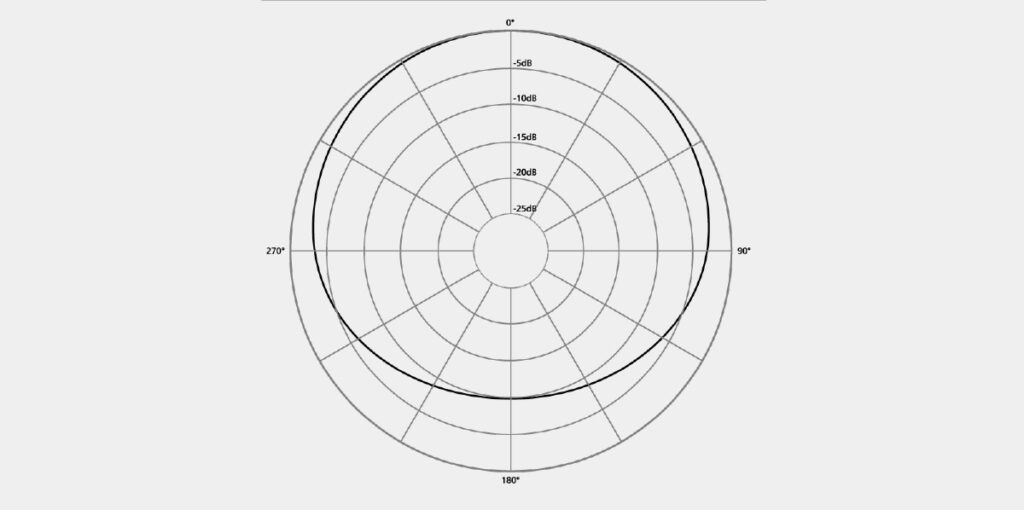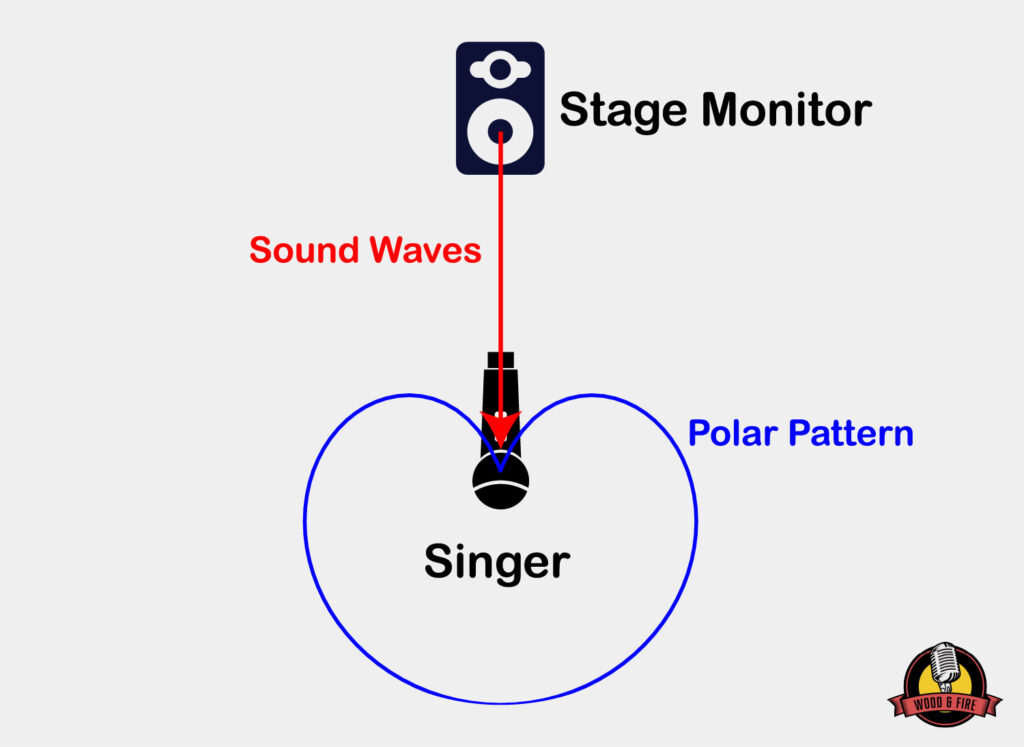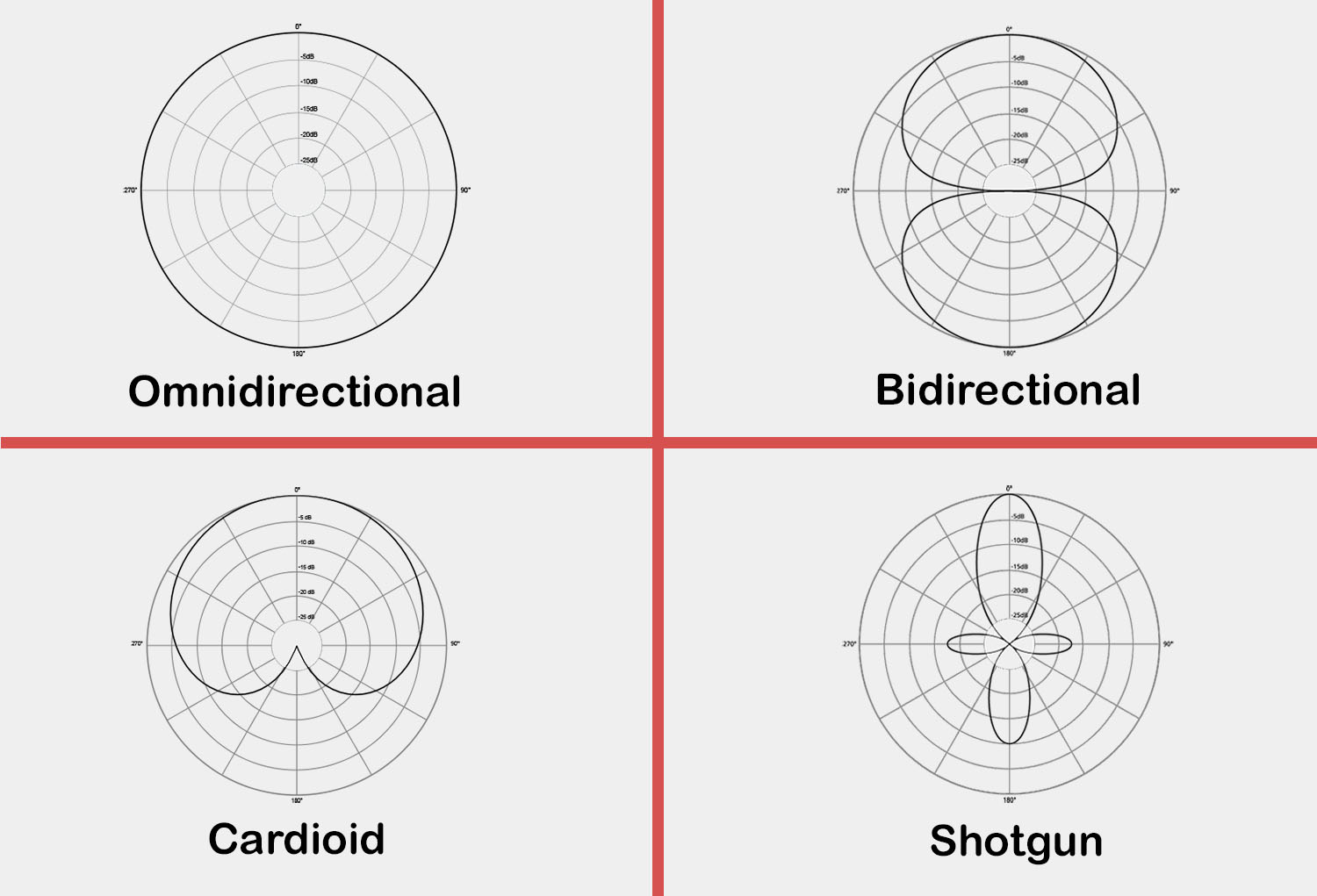The directional characteristic (polar pattern) of a microphone describes how the microphone picks up sound from different directions. Depending on the polar pattern, more or less sound is picked up from the front, from behind or from the side.
Different polar patterns are designed for different purposes - you can use these characteristics to your advantage, such as minimizing live feedback or preventing other unwanted instruments or noise from "bleeding" into the microphone.
How do you read a polar diagram?
Draw an imaginary circle around the microphone. This circle helps us recognize which direction the sound is coming from when it hits the microphone. The 0° mark on the circle points directly forward, toward the front of the microphone, and the 180° mark points directly backward.
Now there is another axis that tells us how sensitive the microphone is in each direction, i.e. how loud the recording will be. This is measured in decibels (dB). In our circle, the smaller circles inside the large circle represent the sensitivity of the microphone. Each smaller circle we move inward represents a -5 dB decrease in sensitivity. This means that the further we move inward, the quieter the sound will be picked up in that direction.
How many polar patterns are there?
There are 3 basic polar patterns: omnidirectional, unidirectional, and bidirectional. In each of these categories, however, there are some variations called "special patterns". In total, there are 7 types.
Cardioid polar pattern (unidirectional)

The cardioid is the most commonly used polar pattern. Microphones with this pattern pick up sound primarily from the front and greatly reduce sound from the back. Sound from the side is also attenuated somewhat, but not as much as sound from behind.
This polar pattern is ideal for live performance to eliminate feedback when using monitors on stage. It attenuates sound most directly on the rear axis of the microphone and is therefore ideal when the microphone is placed directly in front of the monitor, which is often the case. For this reason, the Shure SM58 with its cardioid pattern is the most popular live vocal microphone.
It can also be used for studio recording when you want to isolate a sound source or when you do not want to record too many reflections, just the direct sound. If you are recording in a room that does not sound good acoustically, you should definitely use a microphone with a cardioid polar pattern.
With this polar pattern, the proximity effect is strong and clearly audible. This can be used, for example, if a singer sounds too thin and you want to give the voice more body. However, it can also make the voice sound muffled and unclear if overdone.
Figure-of-eight polar pattern (bidirectional)

Microphones with a figure-of-eight pattern pick up sound from the front and back equally, while suppressing sound from the sides (at 90° and 270°) more than a cardioid pattern.
This pattern is typical of ribbon microphones due to their design. It is ideal for situations where two sound sources are directly facing each other (e.g., during an interview). It can also be used when sound coming from the side should not enter the microphone, such as when 4 wind instruments are placed side by side on stage and each instrument has its own microphone. This allows each instrument to be isolated better than with cardioid microphones.
The proximity effect is strongest with this pattern. The closer the sound source is to the microphone, the more bass is emphasized.
There are two types of transducers used in microphones: pressure transducers, which respond to pressure, and pressure gradient transducers, which respond to pressure differences. The proximity effect occurs only with pressure gradient transducers. Pressure transducers have an omnidirectional characteristic, while pressure-gradient transducers have a figure-of-eight characteristic because the diaphragm is open on both sides to detect the pressure difference between the front and back.
Therefore, the proximity effect is stronger with cardioid microphones than with omnidirectional microphones (which have no proximity effect at all), but weaker than with figure-eight microphones.
Omnidirectional polar pattern (omnidirectional)

The omnidirectional polar pattern picks up sound equally from all directions, forming a uniform sphere around the microphone diaphragm. This pattern is therefore only suitable for studio recordings where the environment is under control.
This polar pattern sounds the most natural because the frequency range is very even. There is no proximity effect, so the bass range sounds very natural. However, the room in which an omnidirectional microphone is used must be acoustically optimized, as the microphone picks up reflections from all sides.
However, the high frequencies at the sides are suppressed a bit - at frequencies above 16 kHz, an omnidirectional microphone almost looks like a figure-of-eight microphone.
This pattern is very susceptible to feedback and is not suitable for live use. However, it is often used for vocal recordings in the studio when the voice needs to sound particularly clear and natural.
Supercardioid and hypercardioid polar patterns

This pickup pattern is similar to the cardioid pickup pattern, but the side sound is much more attenuated. On the other hand, the rear sound is picked up a bit more, similar to the figure-eight pattern.
These two patterns are popular for live performance because they can isolate the instrument better than cardioids. They are also less susceptible to feedback in the range of 125° (supercardioid) and 110° (hypercardioid) to the front axis, making them more suitable than cardioids in certain situations.
A microphone with one or the other directional characteristic is selected depending on the position of the microphones and monitors on stage to minimize feedback.
Shotgun polar pattern

Directional pattern that picks up sound primarily from the front and greatly reduces sound from the sides and back. This pattern is most commonly used in movie recording, when dialog is being recorded and only the voice of an actor is to be captured, but the microphone is out of frame and therefore far away.
This pattern is also well suited for very loud environments where all other patterns would cause feedback, as the shotgun pattern is the least susceptible to feedback.
Subcardioid polar pattern

This polar pattern is often referred to as a "wide cardioid" because the shape is somewhere between an omnidirectional and a cardioid. This pattern provides a very natural sound that works well in quiet environments, but is very susceptible to feedback. Therefore, these microphones cannot be used on loud stages.
These microphones are ideal for studio recording or quiet stages, such as jazz concerts, because they sound very natural and have little proximity effect, similar to an omnidirectional microphone.
This pattern attenuates sound waves slightly from the rear-more than an omnidirectional pattern, but significantly less than a cardioid polar pattern.
The proximity effect on different polar patterns
As mentioned above, the proximity effect is different for each polar pattern, and this must be taken into account when selecting a microphone. Microphones with a very strong proximity effect, such as the figure-of-eight pattern, would be unsuitable for live vocal use because the singer would be constantly moving and the sound would change too much.
The proximity effect is strongest for microphones with figure-of-eight polar patterns and weakest for microphones with omnidirectional polar patterns, where the proximity effect does not occur at all. All others fall somewhere in between, as shown in the table below:

The role of directivity in live concerts
For live performances, special attention must be paid to the polar pattern to minimize feedback. The position and orientation of the microphone and monitor speaker must always be considered, as feedback can occur through this "loop".
The following 3 patterns are generally used for live performance: The cardioid, the supercardioid, and the hypercardioid. The reason for this is that these three patterns are the least susceptible to feedback from the back.
Depending on the position of the monitor in relation to the microphone, a microphone with one or the other directional characteristic is selected. The angle at which the microphone provides the most attenuation must always be considered.
If the monitor is directly behind the microphone (in a straight line to the singer and the microphone), a microphone with a cardioid characteristic should be selected, as this suppresses the sound directly behind the microphone the most.

However, if the monitor is located slightly to the side of the microphone, things get a little more complicated. In this case, you need to estimate the approximate angle to the rear axis of the microphone and select a microphone with a supercardioid or hypercardioid pattern, depending on whether the angle is closer to 45° or 70°.
If the angle is closer to 45°, a supercardioid should be selected, as it will attenuate the sound that hits that angle the most.

However, if the angle is closer to 70°, a hypercardioid microphone should be selected because it will attenuate the sound that hits that angle the most.

Conclusion
The polar pattern plays a very important role in live performance - in the studio you have the environment under control and can be a bit more creative. However, it is also worth experimenting with different patterns in the studio, as other factors such as proximity effect and frequency response vary from pattern to pattern. Try the same microphone on the same source, but with different polar patterns to compare the sonic characteristics.
















